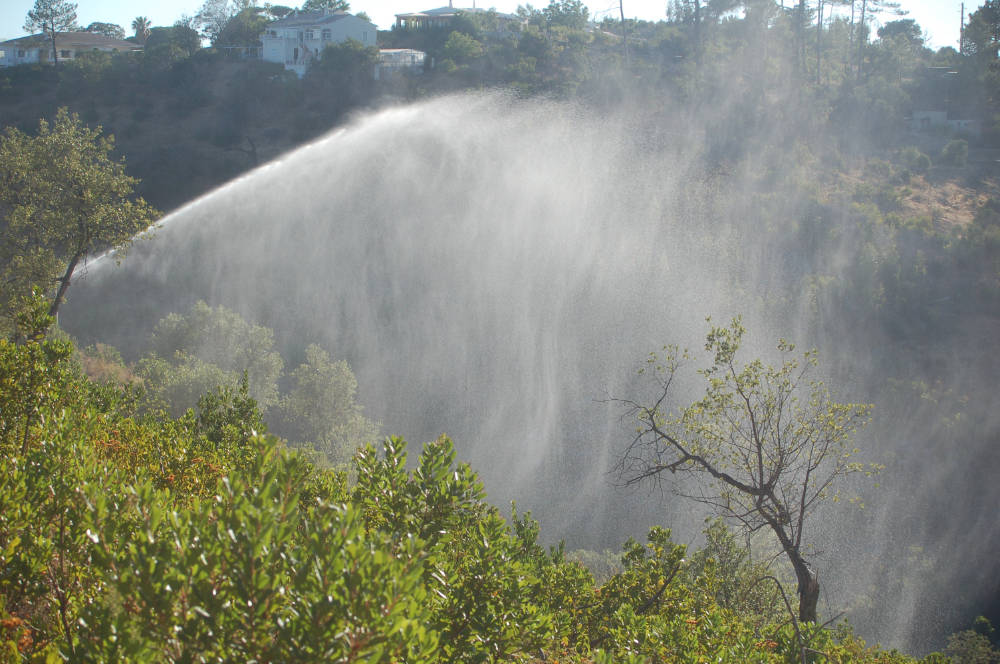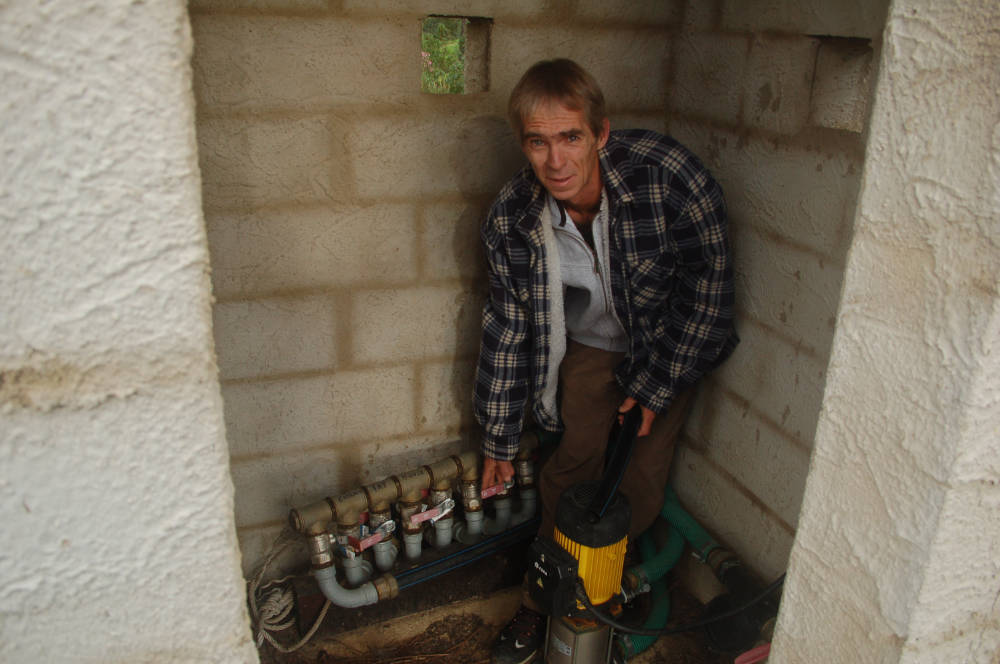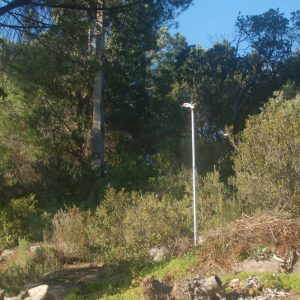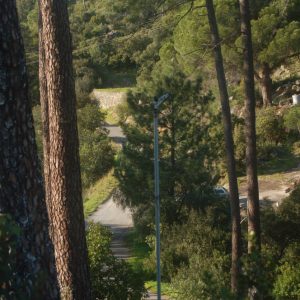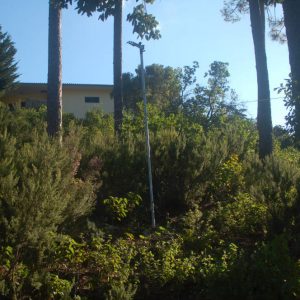Saturday 18th january 2025.

The pictures and films we are currently seeing from California are disturbing. At this very same moment in time, we are installing the tenth high-power sprinkler in our own forest, while we receive the news that the forest and mountains near Los Angeles are ablaze and the winds are mutating into storms and fuelling the fires that are now destroying entire communities. This distinctly reminds us of what happened in the Monchique mountains during the week of 3-10 August 2018, when, according to police reports, a high-voltage E-Redes power line was repeatedly touching against a eucalyptus tree and causing sparks to fly that, in turn, triggered the forest fire in temperatures of 44 degrees Celsius. At 2 p.m. on Saturday, 4 August, when the fire was thought to have been extinguished, the wind shifted from the southeast to the northwest (doesn’t anyone at the civil protection agency check the weather forecast?) and fanned the embers of the extinguished forest fire, causing it to burst into flames once again. This time it was really burning, but, on that Saturday afternoon, the fire departments were already on their way home for the weekend. What have we learned from the many forest fires in Monchique, here in the Algarve?
First and foremost, you have to help yourself: only then will you be resilient; only then will you have a chance. In the midst of this climate crisis, both the state and its politicians – in this case the mayor of Los Angeles, the governor of California and the now decrepit president of the United States – are powerless. We are well aware of the inadequacies of the politicians that we have in Monchique and Portugal and, because we are conservationists, we have come up with a very special idea. First of all, we founded a cooperative that is committed to regarding the forest as a common good that deserves our protection. In addition to humans, there are a whole host of other animals and plants living there. We had just bought a wooded valley, which burned down completely in the August fire after having survived four other forest fires. Armed with a garden hose, I stood next to carob trees that were more than a hundred years old and put out the fire. At least I was able to save almost half of our trees. I had joined five hoses together and managed to create a much larger one that was 250 metres long. The water pressure got lower and lower and, by the end of Wednesday, almost at the end of the fire, the municipal water system collapsed completely and all that came from the hose was just a few drops.
So, in the end, you have to rely only on your own strengths and look for like-minded people with a similar philosophy of creative autonomy. You must enter into cooperation with one another. Because the state and politicians only ever do nothing more than react to events such as this, often too late and inadequately. And an incompetent bureaucracy only exacerbates the problems instead of solving them. Build a large tank and collect your own rainwater, using the gutters of your house. We only need six rainy days a year for 50,000 litres. Install an overflow and fill another tank. Once you’re ready, plant a tree, then a forest, and direct the excess rainwater to the roots of your trees in the garden.
Collect water in winter for the next summer.
Take a DIN/A4 sheet of paper and draw the plan of your forest plot, marking the places where you would start defending against possible forest fires. Are you accounting for wind and storms from the north, from the northwest and also from the northeast? How many gallons of water and how many metres from the cistern should the various sprinklers spray the rainwater? Do you need 25 or 30 metres of distance to protect yourself and others from the fire? Or do you need to remain at a greater distance from the fire? You calculate winds of 80 to 120 kilometres per hour that fuel the fire and drive the sparks, and you build your own resilient anti-fire system. There is a one-and-a-half-inch water pipe running from the cistern to your command centre. That’s what we call the bunker, where you sit comfortably in an armchair and turn the taps on and off. Because the bunker is the headquarters from which the 1¼-inch water pipes lead. Each individual sprinkler has its own water pipe, which is laid underground. That’s almost all you need to do during a forest fire. Be alert. Wear a gas mask and fireproof clothing. And never do this work alone. Four eyes see better than two! Do it together with a friend, a neighbour, or your partner. The garden hose stays near the tap in reserve, and it is only to be used if the fire reaches an area that the sprinklers cannot cover.
Regreening the world
The installation of our own anti-fire system, which we have called WetNet, not only saves lives, but also the very basis of life itself, the forest. It is about protecting a piece of nature that has grown for a long time and is full of life and history. Trees transform carbon dioxide into oxygen, the elixir of life that we need for breathing. Trees provide shade and do their best to balance the climate. Nature always strives to balance out human tendencies, to find a middle ground between the highs and lows, if you let it, if you help the forest to remain a habitat. Forests provide food: nuts, almonds, figs, etc. People who live in the city and do not know forests can hardly assign a real value to a tree. Many try to do it with money. But you will soon realise that we cannot eat money. We must preserve the forest, and we not only need to preserve it, but also to guarantee its diversity. As a cooperative, we wanted to invent a system with which we could protect our forest from fire, after so many forest fires in Monchique. Such a system wasn’t available for purchase yet. So, we made it ourselves. We bought more than a kilometre of (1¼-inch) water pipes, flexible PVC water pipes that can withstand a pressure of up to 10 bar.
And now we have it, and everything is installed. We remember what our ancestors did in the 12th century in the Alentejo, at the Convento de São Paulo in Serra da Ossa near Redondo, when the monks collected the winter rainwater in the cisterns of what is now the basement of a five-star hotel, and, in this way, they always had cool water available in the hot and dry summer months, especially to water the gardens in the dry season. People have to live off something: potatoes, lettuces, tomatoes and onions, and then courgettes, peppers and so many other vegetables. And above all fruit: apricots, peaches, oranges and lemons, and so on; for example, the famous grapes for wine. We in Portugal are so rich, especially in history. We should just be aware of it and remember it. Because water is everything, and without water everything is nothing. And you put out forest fires with water, especially when you douse bone-dry forests with water, so that fires can’t spread in the first place. And what is even more important is the diversity of the forest. It is not the eucalyptus that brings us real wealth, but the diversity of the different native tree species (e.g. cork oaks, chestnut, carob, almond and fig trees and many other different species), which ensures the forest has the moisture it needs to stop it burning again and again. Because eucalyptus and other invasive tree species suck the last reserves of water out of the soil; streams and springs dry up. You have to know the context when you pass laws in Lisbon. And you should take a closer look at the damage that monocultures cause in Portugal and Europe. Because forest fires are caused by man-made climate change…
This story will continue here next week. It has three parts and tells the story of the sprinkler, a technology that can put out forest fires if it is installed correctly and then used carefully.
 Eco123 Revista da Economia e Ecologia
Eco123 Revista da Economia e Ecologia

